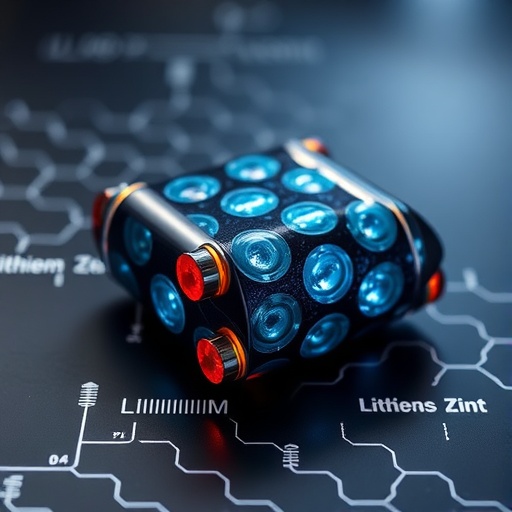The quest for advanced battery technology continues to drive scientific research, particularly in the realm of lithium-ion batteries. A key area of focus is the development of novel cathode materials that offer enhanced performance characteristics, such as higher capacity, improved stability, and efficient cycling behavior. An innovative study recently published in the journal Ionics presents significant breakthroughs in this arena. The research team, led by Ahmed B.R. and comprising Reyhani A. and Khanlary M.R., has synthesized a lithium-rich cathode material that exhibits promising electrochemical properties, making strides toward more efficient energy storage systems.
The cathode material in question is Li[Li₀.₂₀Mn₀.₅₄Ni₀.₁₃Co₀.₁₃]O₂, which has been successfully composited with graphene and doped with zinc. This composite structure aims to address some persistent limitations found in conventional lithium-ion battery materials, chiefly the capacity fading over repeated charge-discharge cycles. By utilizing graphene, renowned for its excellent electrical conductivity and substantial surface area, the research team hypothesizes that they can significantly enhance the electrochemical performance of the lithium-rich cathode.
In practice, the synthesis of this composite material is no small feat. It involves a careful selection of precursors and a rigorous preparation process to ensure the optimal integration of the various components. The researchers utilized an advanced sol-gel method to synthesize the cathode material, followed by the incorporation of graphene, which serves not only as a conductive additive but also aids in stabilizing the active material during cycling. Doping with zinc further modifies the electronic structure of the cathode and influences its electrochemical behavior, thereby potentially enhancing its capacity and cycling stability.
Electrochemical characterization of the synthesized material was conducted to evaluate its performance metrics. The charge-discharge profiles revealed that the lithium-rich cathode exhibits a remarkable specific capacity, exceeding many of the existing materials. The cycling stability of this new material was also assessed, demonstrating an impressive retention of capacity after numerous cycles. This property is crucial for any material intended for practical battery applications, where longevity and durability are paramount.
The researchers also examined the rate capability of the synthesized Li[Li₀.₂₀Mn₀.₅₄Ni₀.₁₃Co₀.₁₃]O₂. The results indicated that the composite material could sustain higher charge and discharge rates without significant loss of performance. This is particularly pertinent for applications requiring rapid energy delivery, such as electric vehicles and portable electronic devices, where swift charge times and robust energy output can significantly enhance user experience and functionality.
To further understand the physical and chemical properties of the new cathode material, the team employed various analytical techniques. X-ray diffraction (XRD) analysis confirmed the successful formation of the desired crystal structure, while scanning electron microscopy (SEM) provided insights into the particle morphology and the uniform distribution of graphene within the composite. These findings underscore the importance of structural integrity in influencing the electrochemical properties of battery materials.
Additionally, the research highlights the significance of doping in enhancing battery performance. The incorporation of zinc not only plays a crucial role in stabilizing the crystal structure but also facilitates lithium-ion diffusion within the lattice, ultimately contributing to the improved electrochemical performance observed. The strategic approach to doping and compounding underscores a trend in battery material research: optimizing the interactions between different elements to harness their collective strengths.
The implications of this study extend beyond mere academic interest; there are real-world applications on the horizon. As societal reliance on energy storage solutions increases, the demand for efficient, reliable, and sustainable battery systems becomes increasingly pressing. Innovations such as the one reported in this study represent a critical step toward developing next-generation batteries that can meet the evolving requirements of modern technology.
As industries shift toward greener technologies, the search for lithium-rich materials and their composites will undoubtedly continue. This study exemplifies a vital contribution to the field, showcasing how interdisciplinary approaches—melding chemistry, materials science, and engineering—can forge pathways to innovation. The potential integration of these advanced cathode materials into commercial battery systems could redefine performance standards and foster advancements across various sectors, including renewable energy, electric mobility, and consumer electronics.
The future of battery technology hinges on such innovative research, emphasizing the importance of continued investigation into complex material systems. With advancements in synthesis techniques and characterization methods, researchers are now better equipped than ever to tackle the challenges surrounding energy storage. The findings from Ahmed B.R. and colleagues serve as a reminder of the exciting possibilities that lie ahead as science continues to unravel the complexities of materials at the atomic level.
In conclusion, the synthesis and thorough characterization of the lithium-rich cathode material Li[Li₀.₂₀Mn₀.₅₄Ni₀.₁₃Co₀.₁₃]O₂ composited with graphene and doped with zinc marks a significant advancement in the pursuit of high-performance battery technologies. As researchers like these push the envelope, we can expect to see widespread ramifications across energy storage technology, enabling a more sustainable future powered by efficient and durable battery solutions.
Subject of Research: Development of lithium-rich cathode materials for lithium-ion batteries.
Article Title: Synthesis and electrochemical characterization of lithium-rich cathode material Li[Li0.20Mn0.54Ni0.13Co0.13]O2 composited with graphene and doped with zinc.
Article References:
Ahmed, B.R., Reyhani, A., Khanlary, M.R. et al. Synthesis and electrochemical characterization of lithium-rich cathode material Li[Li0.20Mn0.54Ni0.13Co0.13]O2 composited with graphene and doped with zinc.
Ionics (2025). https://doi.org/10.1007/s11581-025-06626-1
Image Credits: AI Generated.
DOI: https://doi.org/10.1007/s11581-025-06626-1
Keywords: lithium-rich cathode, electrochemical characterization, battery technology, graphene, zinc doping.




